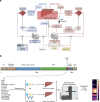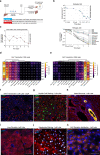Harnessing whole human liver ex situ normothermic perfusion for preclinical AAV vector evaluation
- PMID: 38485924
- PMCID: PMC10940703
- DOI: 10.1038/s41467-024-46194-y
Harnessing whole human liver ex situ normothermic perfusion for preclinical AAV vector evaluation
Abstract
Developing clinically predictive model systems for evaluating gene transfer and gene editing technologies has become increasingly important in the era of personalized medicine. Liver-directed gene therapies present a unique challenge due to the complexity of the human liver. In this work, we describe the application of whole human liver explants in an ex situ normothermic perfusion system to evaluate a set of fourteen natural and bioengineered adeno-associated viral (AAV) vectors directly in human liver, in the presence and absence of neutralizing human sera. Under non-neutralizing conditions, the recently developed AAV variants, AAV-SYD12 and AAV-LK03, emerged as the most functional variants in terms of cellular uptake and transgene expression. However, when assessed in the presence of human plasma containing anti-AAV neutralizing antibodies (NAbs), vectors of human origin, specifically those derived from AAV2/AAV3b, were extensively neutralized, whereas AAV8- derived variants performed efficiently. This study demonstrates the potential of using normothermic liver perfusion as a model for early-stage testing of liver-focused gene therapies. The results offer preliminary insights that could help inform the development of more effective translational strategies.
© 2024. The Author(s).
Conflict of interest statement
L.L. and I.E.A. are co-founders of Exigen Biotherapeutics, a company that utilizes similar technologies broadly discussed in this paper. M.C.-C., I.E.A., and L.L. are inventors on patent applications filed by Children’s Medical Research Institute related to AAV capsid sequences and in vivo function of novel AAV variants (WO2021168509). The remaining authors declare no competing interests.
Figures




References
MeSH terms
Substances
Grants and funding
LinkOut - more resources
Full Text Sources

